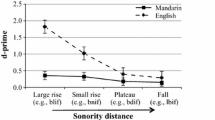Abstract
Two experiments were conducted to examine which of two linguistic syllabification strategies, the maximal onset principle and the stress principle, is operative in auditory word recognition. Test stimuli consisted of bisyllabic words and nonwords containing two medial consonants, the second of which had a potential attachment to either the coda of the first syllable or the onset of the second syllable (e.g., MARKET). A phonological priming paradigm was used in which prime stimuli were artificially syllabified by inserting silence. In the critical conditions, the prime was consistent with the maximal onset principle (e.g., MAR-KET) or with the stress principle (e.g., MARK-ET). The results suggested that listeners prefer to attach a medial consonant to the onset of a syllable in a way that is characterized by the maximal onset principle. The results also indicate some use of the stress principle.
Similar content being viewed by others
References
Bailey, C. J. N. (1978) Gradience in English syllabization and a revised concept of unmarked syllabization. Bloomington IN: Indiana University Linguistics Club.
Balota, D. B., & Chumbley, J. (1984). Are lexical decisions a good measure of lexical access? The role of word frequency in the neglected decision task. Journal of Experimental Psychology: Human Perception & Performance, 10, 340–357.
Connine, C. M., Mullennix, J., Shernoff, E., & Yelen, J. (1990). Word frequency and familiarity in auditory and visual word recognition. Journal of Experimental Psychology: Learning, Memory & Cognition, 16, 1084–1096.
Cutler, A., & Butterfield, S. (1992). Rhythmic cues to speech segmentation: Evidence from juncture misperception. Journal of Memory and Language, 31, 218–236.
Cutler, A., & Foss, D. J. (1977). On the role of sentence stress in sentence processing. Language and Speech, 20, 1–10.
Cutler, A., & Norris, D. (1988). The role of strong syllables in segmentation for lexical access. Journal of Experimental Psychology: Human Perception and Performance, 14, 113–121.
Cutler, A., Mehler, J., Norris, D., & Segui, J. (1983). A language specific comprehension strategy. Nature, 304, 159–160.
Cutler, A., Mehler, J., Norris, D., & Segui, J. (1986). The syllable's differing role in the segmentation of French and English. Journal of Memory and Language, 25, 385–400.
Cutler, A., Norris, D., & Williams, J. N. (1987). A note on the role of phonological expectations in speech segmentation. Journal of Memory and Language, 25, 385–400.
Goldinger, S., Luce, P. A., & Pisoni, D. B. (1989). Priming lexical neighbors of spoken words: Effects of competition and inhibition. Journal of Memory and Language, 28, 501–518.
Hoard, J. W. (1971). Aspiration, tenseness, and syllabification in English. Language, 47, 133–140.
Lima, S. D., & Pollatsek, A. (1983). Lexical access via an orthographic code? The Basic Orthographic Syllabic Structure (BOSS) reconsidered. Journal of Verbal Learning and Verbal Behavior, 22, 310–332.
Miller, J. L. (1981). Effects of speaking rate on segmental distinctions. In P.D. Eimas and J.L. Miller (Eds.), Perspectives on the study of speech. Hillsdale, NJ: Erlbaum.
Pierrehumbert, J., & Nair, R., (1995). Word games and syllable structure. Language and Speech, 38, 77–114.
Pulgram, E. (1970). Syllable, word, nexus, cursus. The Hague: Mouton.
Radeau, M., Morais, J., & Dewier, A. (1989) Phonological priming in spoken word recognition: Task effects. Memory & Cognition, 17, 525–535.
Slowiaczek, L. M., & Pisoni, D. B. (1986). Effects of phonological similarity on priming in auditory lexical decision. Memory & Cognition, 14, 230–237.
Slowiaczek, L. M., Nusbaum, H. C., & Pisoni, D. B. (1987). Phonological priming in auditory word recognition. Journal of Experimental Psychology; Learning, Memory and Cognition, 13, 64–75.
Taft, M. (1979). Recognition of affixed words and the word frequency effect. Memory & Cognition, 7, 263–272.
Treiman, R. (1983). The structure of spoken syllables: Evidence from novel word games. Cognition, 15, 49–74.
Treiman, R. (1986). The division between onsets and rimes in English syllables. Journals of Memory and Language, 25, 476–491.
Treiman, R. (1990). The internal structure of the syllable. In G. Carlson & M. Tanenhaus (Eds.), Linguistic structure in language processing. Dordrecht, The Netherlands: D. Reidel.
Treiman, R., & Danis, C. (1988). Short-term memory errors for spoken syllables are affected by the linguistic structure of the syllable. Journal of Experimental Psychology: Learning Memory and Cognition, 14, 145–152.
Treiman, R., & Zukowski, A. (1990). Toward an understanding of English syllabification. Journal of Memory and Language, 29, 66–85.
Treiman, R., Gross, F., & Cwikiel-Glavin, A. (1992). The syllabification of 1st clusters in English. Journal of Phonetics, 20, 383–402.
Vennemann, T. (1988). Preference laws for syllable structure and the explanation for sound change. Berlin: Mouton de Gruyter.
Author information
Authors and Affiliations
Corresponding authors
Rights and permissions
About this article
Cite this article
Titone, D., Connine, C.M. Syllabification strategies in spoken word processing: Evidence from phonological priming. Psychol. Res 60, 251–263 (1997). https://doi.org/10.1007/BF00419410
Received:
Accepted:
Issue Date:
DOI: https://doi.org/10.1007/BF00419410




